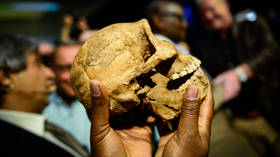Scientists find world’s oldest known burial site in Africa

Scientists have made a discovery in South Africa, unearthing the world’s oldest known burial site on record containing the remains of a small-brained species that was previously believed to be incapable of exhibiting complex behavior.
Researchers led by American palaeoanthropologist Lee Berger announced the discovery on Monday, claiming that members of an ancient human species known as Homo naledi buried their dead and engraved symbols on the walls of tombs. This represents the “earliest evidence of multiple interments and funerary actions” predating burials by “Homo sapiens by at least 100,000 years,” the scientists said in a preprint of two research papers available on bioRxiv.
Skeletal remains of Homo naledi, who had a brain size about one-third that of modern humans and who are known for their ability to climb trees, were discovered in an underground cave system located around 30 meters (100 feet) within the Cradle of Humankind – an esteemed UNESCO World Heritage Site located about 25 miles northwest of Johannesburg. The specimens are said to be dated between 335,000 and 241,000 years ago, making them the earliest known burials by at least 100,000 years.
Berger’s team initially discovered the Homo naledi in 2015, raising the possibility of intentional burials due to the location and intactness of the bone fragments deep within the cave system. Skeptics suggested alternative explanations such as water deposition or the involvement of modern humans.
However, subsequent discoveries made by the team in 2017 have provided further evidence supporting deliberate burials. These discoveries include shallow pits containing bone fragments that were potentially dug by Homo naledi and variations in fill material within the pits, in addition to abstract shapes and patterns etched into the cave walls near the burials, suggesting a cognitive step in human evolution.
The findings, according to the researchers, challenge the belief that such behaviors were unique to Neanderthals and modern Homo sapiens and further raises questions about the relationship between Homo naledi and contemporary human beings.













